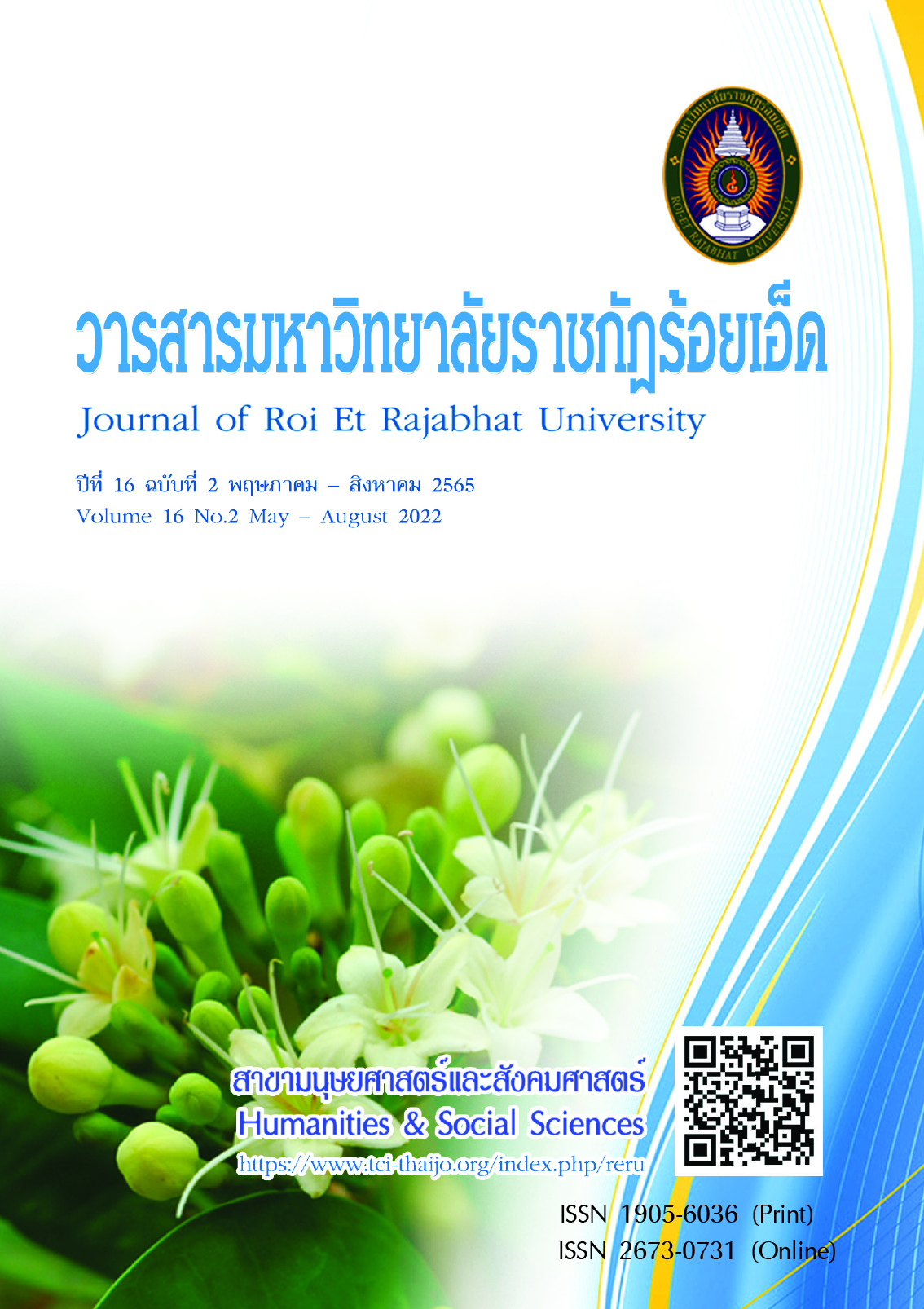Effects of Story Maps on Reading Comprehension Skill Improvement of Thai EFL Sixth Graders
Keywords:
Reading Comprehension, Story Map, NarrativesAbstract
This present study aimed to investigate the effects of story maps on Thai EFL sixth graders’ reading comprehension skills and to examine the students’ attitudes toward the story map implementation into their reading comprehension skill improvement. The story maps were adopted as an instructional strategy intended to improve the students’ reading comprehension skills of narratives at a literal comprehension level. The participants were thirteen sixth grade students in an opportunity extension school in the Northeast of Thailand. The implementation of the story maps lasted for eight weeks.
The period for instruction in each week was two hours. The instruments for data collection were reading comprehension pre-test and post-test and a student attitude questionnaire. The findings of this study showed that there was a statistically significant difference at the 0.01 level in the students’ narrative reading comprehension skills before and after using the story maps. The students’attitudes towards
the implementation of the story maps were found at a high level with a mean score of 3.78.
References
Barrantes T. D. (2015). Effectiveness of the Use of Graphic Organizers and Summaries: A Case Study of Adult EFL Students in a Reading Comprehension Course. Revista de Lenguas Modernas, 22, 267-295. https://doi.org/10.15517/rlm.v0i22.19685
Boulineau, T., Fore, C., Hagan-Burke, S. and Burke, M. D. (2004). Use of Story-Mapping to Increase the Story-Grammar Text Comprehension of Elementary Students with Learning Disabilities. Learning Disability Quarterly, 27(2), 105–121.
Chawwang, N. (2008). An Investigation of English Reading Problems of Thai 12th- Grade Students in Nakhonratchasima Educational Regions 1, 2, 3, and 7. Master thesis in Teaching English as a Foreign Language. Bangkok: Graduate School, Srinakharinwirot University.
Darmawan, S. L. (2013). Promoting students’ explicit information skill in reading comprehension through graphic organizers. Premise Journal of English Education, 2(2), 112–119. https://doi.org/10.24127/pj.v2i2.684
Day, R. R. and Bamford, J. (1998). Extensive reading in the second language classroom. Cambridge: Cambridge University Press.
Duke, N. K. and Pearson, P. D. (2002). Effective Practices for Developing Reading Comprehension. A. E. Forstup & S. J. Samuels (Eds.), What research has to say about reading instruction (pp. 205-242). Newark, DE: International Reading Association. https://doi.org/10.1598/0872071774.10
Franciscone, J. (2008). The effectiveness of using story mapping as a supplemental tool to improve reading comprehension (Order No. 1454281). Available from ProQuest Dissertations & Theses Global. (89190605). Retrieved February 20, 2020, from https://www.proquest.com/docview/89190605?accountid=50152
Grünke, M., Wilbert, J. and Stegemann, C. K. (2014). Analyzing the Effects of Story Mapping on the Reading Comprehension of Children with Low Intellectual Abilities. Learning Disabilities: A Contemporary Journal, 11(2), 51–64.
Idol, L. (1987). Group story mapping: A comprehension strategy for both skilled and unskilled readers. Journal of Learning Disabilities, 20(4), 196–205.
Isikdogan, N. and Kargin, T. (2010). Investigation of the effectiveness of the story-map method on reading comprehension skills among students with mental retardation. Educational Sciences: Theory & Practice, 10(3), 1509–1527.
Jiang, X. and Grabe, W. (2007). Graphic organizers in reading instruction: Research findings and issues. Reading in a Foreign Language, 19(1), 34–55.
Jittisukpong, P. (2019). Using Semantic Mapping in Teaching English Reading Skills of Thai EFL Learners. Journal of Roi Et Rajabhat University, 13(2), 201-214. Retrieved November 28, 2020, from https://so03.tci-thaijo.org/index.php/reru/article/view/213071
Li, K. L. and Wen, N. P. (2017). The Use of Story Map in Improving the Year Four Pupils’ Ability in Reading Comprehension. Journal of English Education, 2(1), 59–67.
Lyman, F.T. (1981). The responsive classroom discussion: the inclusion of all students. In A.S. Anderson (Ed.), Mainstreaming Digest (pp. 109–113). College Park, MD: University of Maryland Press.
Ministry of Education, T. (2008). The Basic Education Core Curriculum. 2551. Bangkok: The Express Transportation Organization of Thailand.
Ministry of Education, T. (2015). The Common European Framework of Reference for Languages (CEFR). Bangkok: English Language Institute.
National Institute of Educational Testing Service (Public Organization). (2016-2018). The Report of National Test for Basic Education Level (O-NET) 2016-2018 academic year. Retrieved December 20, 2019, from http://www.niets.or.th
Nurpitriyani, D. (2015). The Effectiveness of Story Mapping Technique toward Students’ Reading Comprehension
of Narrative Text; A Quasi Experimental Study at the Tenth Grade Students of SMAN 1 Kota Tangerang Selatan in the Academic Year of 2014/1015. Thesis Strata I (S.Pd.) in English Language Education. Banten: Syarif Hidayatullah State Islamic University Jakarta.
Özmen, G. R. (2011). Comparison of Two Different Presentations of Graphic Organizers in Recalling Information in Expository Texts with Intellectually Disabled Students. Educational Sciences: Theory & Practice, 11(2), 785–793.
Padungkit, P. (2009). Using the Technique of Teaching Reading for Communication to Improve Reading Ability of Secondary School Students. Master thesis in Teaching English as a Foreign Language. Bangkok: Srinakharinwirot University.
Sawangsamutchai, Y. and Rattanavich, S. (2016). A Comparison of Seventh Grade Thai Students’ Reading Comprehension and Motivation to Read English through Applied Instruction Based on the Genre-Based Approach and the Teacher’s Manual. English Language Teaching, 9(4), 54-63. https://doi.org/10.5539/elt.v9n4p54
Splittstoesser, J. (2020). The Effectiveness of Story Maps on Reading Comprehension. Thesis Master of Arts in Education School of Humanities, Arts and Sciences. St. Paul, Minnesota: Saint Catherine University.
Vásquez, J. M. and Zúñiga, C. R. (2018). Graphic organizers as a teaching strategy for improved comprehension of argumentative texts in English. Actualidades Investigativas En Educación, 18(2). https://doi.org/10.15517/aie.v18i2.33028
Wei, Y. (2005). The relationship between phonological awareness and reading ability of Thai students in English and Thai primary schools of Thailand. Curriculum & Instruction Theses and Dissertations UM Theses and Dissertations. (UMI No.3175161). ProQuest Information and Learning: Collage Park.
Downloads
Published
How to Cite
Issue
Section
License
Copyright (c) 2022 Roi Et Rajabhat University

This work is licensed under a Creative Commons Attribution-NonCommercial-NoDerivatives 4.0 International License.
บทความที่ได้รับการตีพิมพ์เป็นลิขสิทธิ์ของวารสารมหาวิทยาลัยราชภัฎร้อยเอ็ด
ข้อความที่ปรากฏในบทความแต่ละเรื่องในวารสารวิชาการเล่มนี้เป็นความคิดเห็นส่วนตัวของผู้เขียนแต่ละท่านไม่เกี่ยวข้องกับมหาวิทยาลัยราชภัฎร้อยเอ็ด และคณาจารย์ท่านอื่นๆในมหาวิทยาลัยฯ แต่อย่างใด ความรับผิดชอบองค์ประกอบทั้งหมดของบทความแต่ละเรื่องเป็นของผู้เขียนแต่ละท่าน หากมีความผิดพลาดใดๆ ผู้เขียนแต่ละท่านจะรับผิดชอบบทความของตนเองแต่ผู้เดียว





